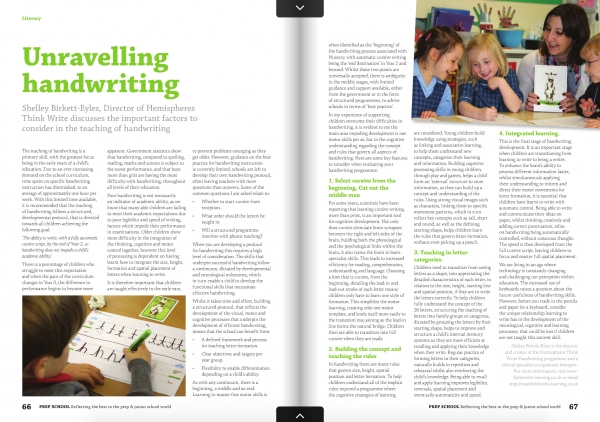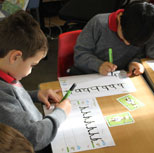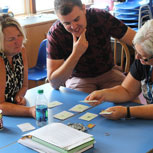Unravelling Handwriting

Unravelling Handwriting
Shelley Birkett-Eyles, Director of Hemispheres Think Write and Clinical Specialist Occupational Therapist, Discusses the Important Factors to Consider in the Teaching of Handwriting.
The teaching of handwriting is a primary skill, with the greatest focus being in the early years of a child’s education. Due to an ever-increasing demand on the school curriculum, time spent on specific handwriting instruction has diminished, to an average of approximately one hour per week. With this limited time available, it is recommended that the teaching of handwriting follows a structured, developmental protocol, that is directed towards all children achieving the following goal:
‘The ability to write, with a fully automatic cursive script, by the end of Year 2, so handwriting does not impede a child’s academic ability’.
There is a percentage of children who struggle to meet this expectation and when the pace of the curriculum changes in Year 3, the difference in performance begins to become more apparent. Government statistics show that handwriting, compared to spelling, reading, maths and science is subject to the worst performance, and that boys more than girls are having the most difficulty with handwriting, throughout all levels of their education.
Poor handwriting is not necessarily an indicator of academic ability, as we know that many able children are failing to meet their academic expectations due to poor legibility and speed of writing, factors which impede their performance in examinations. Older children show more difficulty in the integration of the thinking, cognitive and motor control together, however this level of processing is dependent on having learnt how to integrate the size, height, formation and spatial placement of letters when learning to write.
It is therefore important that children are taught effectively in the early ears, to prevent problems emerging as they get older. However, guidance on the best practice for handwriting instruction is currently limited, schools are left to develop their own handwriting protocol, often leaving teachers with more questions than answers. Some of the common questions I am asked relate to:
• Whether to start cursive from Reception.
• What order should the letters be taught in.
• Will a structured programme interfere with phonic teaching?
When you are developing a protocol for handwriting this requires a high level of consideration. The skills that underpin successful handwriting follow a continuum, dictated by developmental and neurological milestones, which in turn enable a child to develop the functional skills that necessitate effective handwriting.
Whilst it takes time and effort, building a structured protocol, that reflects the development of the visual, motor and cognitive processes that underpin the development of efficient handwriting, means that the school can benefit from:
• A defined framework and process for teaching letter formation.
• Clear objectives and targets per year group.
• Flexibility to enable differentiation depending on a child’s ability.
As with any continuum, there is a beginning, a middle and an end. Learning to master fine motor skills is often identified as the ‘beginning’ of the handwriting process associated with Nursery, with automatic cursive writing being the ‘end destination’ in Year 2 and beyond. Whilst these two points are universally accepted, there is ambiguity in the middle stages, with limited guidance and support available, either from the government or in the form of structured programmes, to advice schools in terms of ‘best practice’.
In my experience of supporting children overcome their difficulties in handwriting, it is evident to me the main area impeding development is not motor skills per se, but in the cognitive understanding regarding the concept and rules that govern all aspects of handwriting. Here are some key features to consider when evaluating your handwriting programme:
1. Select Cursive from the Beginning, Cut out the Middle Man.
For some years, scientists have been reporting that learning cursive writing, more than print, is an important tool for cognitive development. Not only does cursive stimulate brain synapses between the right and left sides of the brain, building both the physiological and the psychological links within the brain, it also trains the brain to learn specialist skills. This leads to increased efficiency for reading, comprehension, understanding and language. Choosing a font that is cursive, from the beginning, detailing the lead-in and lead-out stroke of each letter means children only have to learn one style of formation. This simplifies the motor learning, creating only one motor template, and lends itself more easily to the transition into joining as the lead-in line forms the natural bridge. Children then are able to transition into full cursive when they are ready.
2. Building the Concept and Teaching the Rules.
In handwriting there are many rules that govern, size, height, spatial position and letter formation. To help children understand all of the implicit rules requires a programme where the cognitive strategies of learning are considered. Young children build knowledge using strategies, such as linking and associative learning, to help them understand new concepts, categorise their learning and information. Building cognitive processing skills in young children, through play and games, helps a child form an ‘internal’ structure to store information, so they can build up a concept and understanding of the rules. Using strong visual images such as characters, linking them to specific movement patterns, which in turn reflect key concepts such as tall, short and round, as well as the defining starting shape, helps children learn the rules that govern letter formation, without even picking up a pencil.
3. Teaching in Letter Categories.
Children need to transition from seeing letters as a shape, into appreciating the detailed characteristics of each letter, in relation to the size, height, starting line and spatial position, if they are to write the letters correctly. To help children fully understand the concept of the 26 letters, structuring the teaching of letters into family groups or categories, dictated by grouping the letters by their starting shape, helps to improve and structure a child’s internal memory systems so they are more efficient at recalling and applying their knowledge when they write. Regular practice of forming letters in their categories, naturally builds in repetition and rehearsal whilst also reinforcing the child’s knowledge. Being able to recall and apply learning improves legibility, reversals, spatial placement and eventually automaticity and speed.
4. Integrated Learning.
This is the final stage of handwriting development. It is an important stage when children are transitioning from learning to write to being a writer. To enhance the brain’s ability to process different information faster, whilst simultaneously applying their understanding to inform and direct their motor movements for letter formation, it is essential that children have learnt to write with automatic control. Being able to write and communicate their ideas on paper, whilst thinking creatively and adding correct punctuation, relies on handwriting being automatically controlled, without conscious thought. The speed is then developed from the full cursive script, leaving children to focus and master full spatial placement.
We are living in an age where technology is constantly changing and challenging our perception within education. The increased use of keyboards raises a question about the future usefulness of handwriting skills. However, before you trade in the pencils and paper for a keyboard, consider the unique relationship learning to write has in the development of the neurological, cognitive and learning processes, that could be lost if children are not taught this ancient skill.
Shelley Birkett-Eyles is the Director and Creator of the Hemispheres Think Write Handwriting Programme and a Clinical Specialist Occupational Therapist.
for more information email enquiries@thinkwrite-learning.co.uk

|

















 offers all schools a lively engaging way of teaching handwriting
offers all schools a lively engaging way of teaching handwriting